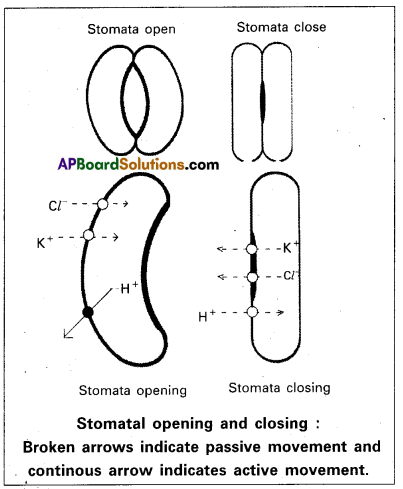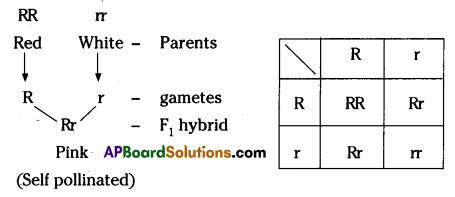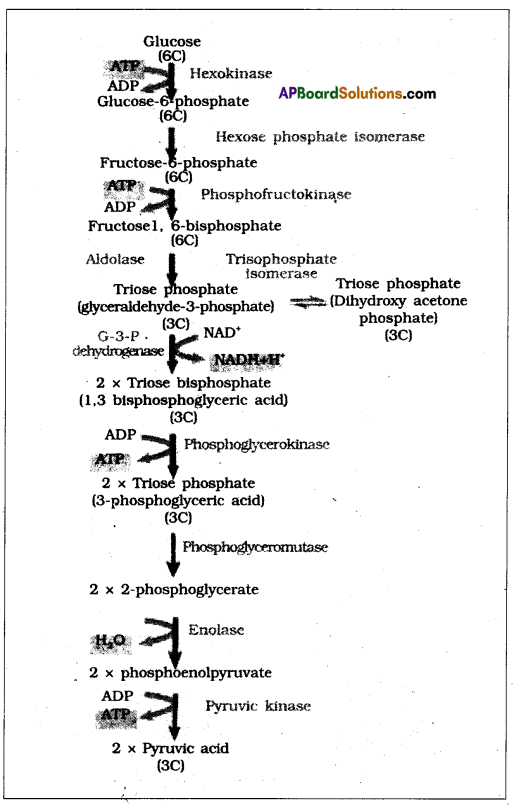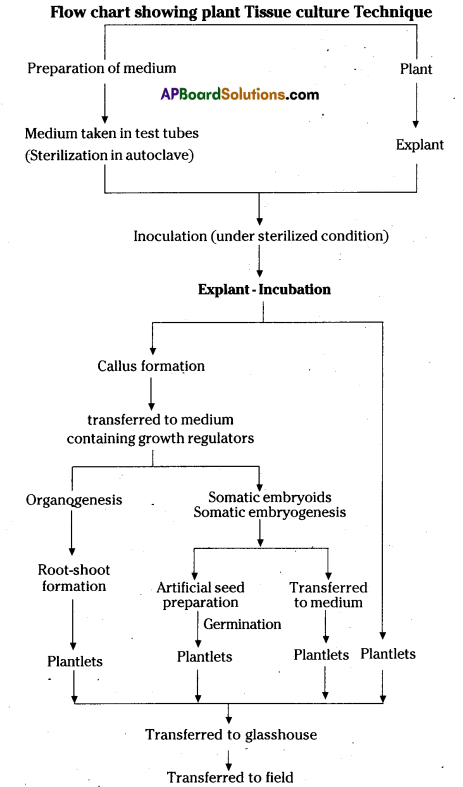Thoroughly analyzing TS Inter 2nd Year Botany Model Papers and TS Inter 2nd Year Botany Question Paper March 2015 helps students identify their strengths and weaknesses.
TS Inter 2nd Year Botany Question Paper March 2015
Time : 3 Hours
Max. Marks: 60
Note: Read the following instructions carefully.
- Answer all questions of Section A. Answer any six questions out of eight In Section B and answer any two questions in Section C.
- In Section-A, questions from Sr. Nos. 1 to 10 are of “Very Short Answer Type”. Eàch question carries two marks. Every answer may be limited to five lines. Answer all these questions at one place in the same order.
- In Section B, questions from Sr. Nos. 11 to 18 are of “Short Answer Type”. Each question carries four marks. Every answer may be limited to 20 lines.
- In Section-C, questions from Sr. Nos. 19 to 21 are of “Long Answer Type”. Each question carries eight marks. Every answer may be limited to 60 lines.
- Draw labelled diagrams wherever necessary for questions in Sections B and C.
Section-A
10 x 2 = 20
Note: Answer all questions. Each answer may be limited to 5 lines.
Question 1.
What are apoplast and symplast?
Answer:
| Apoplast | Symplast |
| 1. Apoplast is the path of water within the plant that moves without crossing membranes. | 1. Symplast is the path of water movement in the plant system that crosses the membranes. |
| 2. It Is faster process. | 2. It is a slower process. |
Question 2.
Explain the role of the pink color pigment in the root nodules of legume plants. What is it called?
Answer:
Oxygen scavenger (or) ¡t removes oxygen from the vicinity of the nitrogenase enzyme. It is called Ieg-haemoglobin.
Question 3.
What is the shape of T.M.V.? What is its genetic material?
Answer:
The shape of T.M.V Is road shape. its genetic materìal is SSRNA. (Single stranded RNA).
Question 4.
What is the cross between the F1 progeny and the homozygous recessive parent called? How is It useful?
Answer:
Test cross. It is used to test whether an individual Is homozygous (pure) or heterozygous (hybrid).
![]()
Question 5.
The sequence of coding strands of DNA in a transcription unit is 5’ – GGAATI’CCG -3’. What is the sequence of nucleotides of the following?
(a) Its complementary strand
(b) The mRNA
Answer:
(a) 3’ – CCTTAAGGC -5’
(b) 3’ – GGAAUUCCG -5’
Question 6.
What is the difference between exons and introns?
Answer:
| Exons | Introns |
| 1. Expressed sequences | 1. Intervening sequences. |
| 2. They appear ¡n nature or processed RNA. | 2. They do not appear in nature or processed RNA. |
Question 7.
What is the full form of PCR? How is it useful, in biotechnology?
Answer:
PCR stands for polymerase chain reaction. It can be used for the diagnosis of diseases like Aids, middle ear infection and tuberculosis.
Question 8.
What is Green Revolution? Who is regarded as father of Green Revolution?
Answer:
The dramatic increase in food production due to plant breeding techniques is called green revolution. Norman Borlaug is regarded as the father of Green Revolution.
Question 9.
What is the chemical nature of biogas ? Name the bacteria involved in the production of biogas.
Answer:
Biogas comprises methane (CH4), CO2, traces of H2S and moisture Methanobacterium is involved in production of biogas.
Question 10.
What is meant by germplasm collection?
Answer:
The entire collection of plants/seeds, having all the diverse alleles for all genes In a given crop is called germ plasm collection.
![]()
Section-B
6 x 4 = 24
Note: Answer any six questions. Each answer may be limited to 20 lines.
Question 11.
Write the physiological responses of Gibberellins in plants.
Answer:
- Gibberellins delay senescence. Thus fruits can be left on the tree longer so as to extend the market period.
- Spraying of Gibberellins on sugarcane crop, increases the length of the stem, thus increasing the yield as much as 20 tonnes per acre.
- GA hastens the maturity period of conifers thus leading to early seed production.
- GA also promotes bolting in cabbages, beet etc.
- They also produce parthenocarpic fruits in grapes and tomatoes.
- Gibberellins favour the formation of male flowers in cucurbita.
- They also promote to enhance the length of grape stalks.
Question 12.
Tabulate any eight differences between C3 and C4 plants/cycles.
Answer:
| C3 Plants | C4 plants |
| 1. Leaves do not show kranz anatomy. | 1. Leaves show Krenz anatomy. |
| 2. Chloroplasts are similar and do not show dimorphism. | 2. Chloroplast dimorphism is seen. |
| 3. The primary acceptor of CO2= RUBP. | 3. The primary acceptor of CO2 is PEPA. |
| 4. The first stable product is = PGA(3c). | 4. The first stable product is = OAA(4c). |
| 5. They are less efficient In utilising atmospheric CO2. | 5. They are more efficient in utilizing atmospheric CO2. |
| 6. Photorespiration is very high. | 6. Photorespiration is not detectable. |
| 7. The optimum temperature is 15-25°C | 7. The optimum temperature is 30-45°C |
| 8. They utilise 18 ATP molecules to synthesise glucose. | 8. Photosynthetic yield is very high. |
| 9. Photosynthetic yield is low. | 9. They utilise 30 ATP molecules to synthesize glucose. |
| 10. They utilise water less efficiently. | 10. They utilise water more efficiently. |
| 11. CO2 compensation point is very High. | 11. CO2 compensation point is low. |
Question 13.
How does ascent of sap occur in tall plants?
Answer:
Upward movement of water through xylem against gravitational force is called ascent of sap. The transpiration-driven ascent of xylem sap depends on (a) cohesion – mutual attraction between water molecules (b) Adhesion – attraction of water molecules to polar surfaces (c) transpiration pull – driving force for upward movement of water. These properties give water high tensile strength and high capillarity.
In plants, capillarity is aided by the small diameter of the tracheary elçments. As water evaporates through the stomata, Since the thin film of water over the cells is continuous, it results in pulling of water, molecule by molecule into the leaf from the xylem. Also, because of lower concentration of water vapour in the atmosphere.
water diffuses into the surrounding air. This creates transpiration pull. The forces generated by the transpiration can create pressure sufficient to lift a xylem-sized column of water over 130 metres high.
Question 14.
Explain the mechanism of opening and closing of stomata.
Answer:
Mechanism of opening and closing of stomata: Levitt (1974) proposed K+ pump theory to explain the opening and closing of stomata.

According to this, K+ ions are accumulated into guard cells from the subsidiary cells in the presence of light. This coupled with efflux of protons leads to increase in pH of the guard cells. K+ Ion accumulation is associated with influx of C ions to decrease the water potential of guard cells. Water enters into guard cells making them turgid. The outer walls of the guard cells are thin, expand outwardly with the help of microfibrils in the cell walls of guard cells resulting in opening of stomata.
At night, the K+ and cr ions move out of the guard cells due to which the water potential of guard cells increases and water stands moving out of gùard cells leading to the closure of stomata.
![]()
Question 15.
Explain the process of conjugation in bacteria.
Answer:
Transfer of Genetic material between two live Bacteria is called conjugation. It was first observed in 1946 by Lederberg and Tatum in Escherichia coil.
In E.Coii, a small circular DNA stand occurs in the cytoplasm in addition to nucleoìd called on f plasmid. The cell with f plasmid is called f+ cell and without f plasm Id is called f– cell. The f+ cell or donar cell produces the sex pilus that makes contact with the recipient cell or f– cell. During conjugation, f+, and f– cells bind with each other with the help of sex which forms a bridge between them. The f plasmid seplicat and the replicated DNA paeses through bridge to the f– cell. The f– cell becomes f– cell as it receives the f+ plasmid. After conjugation, the two cells separated from each other.

Question 16.
Explain incomplete dominance with example.
Answer:
Incomplete dominance: It is the condition where one allele of a gene is not completely dominant over the other allele and results in the heterozygotes having phenotype different from the dominant and recessive homozygotes.
Ex: In a cross between a true-breeding read flowered plant (RR) and true breeding white-flowered plant (rr), the F1 was pink (Rr). When the F1 was self-pollinated, the F2 resulted in the ratio of
RR:Rr: rr
1:2 :1
Red Pink White
Here the genotype ratios were as in the monohybrid cross of Mendel but the phenotypic ratio had changed from 3: 1 because ‘R was not completely dominant over r and is possible to distinguish Rr’ as pink from ‘RR and rr’.

Question 17.
Write the important features of genetic code.
Answer:
- The code is triplet. 61 codons code for 20 amino acids and 3 codons do not code for any amino acids called stop codons. [UAA, UAG, UGA]
- One codon codes for only one amino acid hence it is unambiguous and specific.
- Some amino acids are coded by more than one codon hence the code is degenerate.
- The codon is read in mRNA in a contiguous fashion. There are no punctuations.
- The code Is nearly universal. E.g.: UUU code for phenylalanine in bacteria and humans.
- AUG has dual functions. ¡t codes for Methionine (Met) and also acts as the initiator codon.
Question 18.
Give a brief account of Bt-cotton.
Answer:
Some strains of Bacillus thuringiens is produce proteins that kill certain Insects such as lepidopterans (tobacco budworm, armyworm), coleopterans (beetles) and dipterans (files, mosquitoes). Bacillus thuringiens is forms protein Crystals which contain a toxic insecticidal protein. The gene responsible for the production of this toxic protein is introduced genetically into the cotton seeds protects the plants from Bollworm, a Major pest of cotton. Use of Bt. Cotton has led to 3- 27% increase in cotton yield in countries where it is grown.
The toxin is coded by a gene named ‘cry’. The proteins encoded by the genes cry lAc and cry hAb control the cotton bollworms and cry iAb controls corn borer.
Section-C
2 x 8 = 16
Note : Answer any two questions. Each answer may be limited to 60 lines.
Question 19.
Describe the process of various biochemical reactions that occur during Glycolysis.
Answer:
Glucose is broken down into 2 molecúles of pyruvic acid ¡s called glycolysis. It was given by Gustav Ernbden, Otto Mayerhof and J. Parnas so called EMP pathway. It occurs in the cytoplasm of the cell and take place in all living organisms. In this, 4 ATP are formed of which two are utilised and 2NAPDH + H+ are formed. At the end of glycolysis, 2PA, 2ATP and 2NADPH + H+ are formed as end products. The ATP and NADPH + H+ are utilised for fixation of CO2.

Reactions:
1. Glucose is phosphorylated in the presence of Kinase to form glucose-6-phosphate.
Glucose + ATP → Glucose-6-phosphate + ADP
2. G-6P is isomerised to Fructose-6-phosphate in the presence of Isomerase.
G-6P → F6P
3. Fructose 6 phosphate is phosphorylated in the presence of hexokinase to form Fructose 1, 6 Biphosphate.
G6P+ATP → F1,6BiP+ADP
4. F 1, 6 BiP undergoes cleavage In the presence of Aldolase to form 1 Dihydroxy acetone phosphate and 1 Glyceraldehyde
3 phosphate
F1,6BiP →1 DHAP+ 1G3P
5. DHAP does not undergo oxidation in further reactions, so gets isomerised to another G3P in the presence of Isomerase.
1 DHAP → 1G3P
6. 2 molecules of G3P undergoes dehydrogenation in the presence of dehydrogenase to form 2 molecules of 1,3 DPGA.
2G3P + 2NAD 2 →1,3 DPGA + 2NADH + H+
7. 2 mol. of 1, 3 DPGA undergoes dephosphorylation in the presence of phosphor Glycerokinase-to form 2 mol. of 3 PGA
2-1,3DPGA + 2ADP → 2-3PGA+2ATP
8. 2 mol. of 3PGA are converted into 2 mol. of 2PGA in the presence of mutage.
2-3PGA → 2-2 PGA
9. 2-PGA looses water molecules to form 2-phosphoenol pyruvic acid in the presence of Enojase.
2-2PGA → 2-PEPA+H2O
10. 2 PEPA mols. are phosphorylated in the presence of pyruvic kinase to form 2 pyruvic acid molecules.
2PEPA+2ADP → 2ATP+2PA
![]()
Question 20.
Give a brief account of the tools of recombinant DNA technology.
Answer:
Key tools are:
1) Restriction enzymes: Two enzymes responsible for restricting the growth of Bacteriophage in Escherichia cou were isolated in the year 1963. One of these added methyl groups to DNA and the other cut DNA. The latter was called restriction endonuclease. The first restriction endonuclease – Hind II which cut DNA molecules at a particular point by recognising a specific sequence of six base pairs, called recognition sequence for Hind II. Today more than 900 restriction enzymes were isolated from over 200 strains of Bacteria, each of which recognises a different recognition sequence.
E CORI is a restriction enzyme in which, the first letter comes from the genus (Escherichia), and the second two letters from the species of the Prokaryotic cell [colij, the letter R’ is derived from the name of strain. Roman numbers indicate the order in which the enzymes were isolated from that strain of Bacteria. Restriction enzymes belong to a larger class of enzymes called nucleases.
They are of two types.
- Exonucleases which remove nucleotides from the ends of the DNA.
- Endonucleases which make cuts at specific locations within the DNA.
Most restriction enzymes cut the two strands of DNA double helix at different locations. Such a cleavage Is known as a staggered cut. E CoRI recognises 5’ GAA7T3’ sites on the DNA and cuts it between G and A results in the formation of sticky ends or cohesive end pieces. This stickyness of the ends facilitates the action of enzyme DNA ligase.
2. Cloning vectors: The DNA used as a carrier for transferring a fragment of foreign DNA into a suitable host is called vector. Vectors used for multiplying the foreign DNA sequences are called cloning vectors. Commonly used cloning vectors are plasm ids, bacteriophages, cosmids. Plasm ids are extrachromosomal circular DNA molecules present in almost all bacterial species. They are inheritable and carry few genes are easy to isolate and reintroduce into the bacterium Host.
Features required to facilitate cloning into a vector:
a) Origin of replication: (on) This is a sequence from where replication starts and any piece of DNA when linked to this sequence can be made to replicate within host cells. It is also responsible for controlling the copy number of the linked DNA.
b) Selectable marker: In addition to ‘on’, the vector requires a selectable marker, which helps in identifying and eliminating non-transformants and selectively permitting the growth of the any transformants normally, the genes encoding resistance to antibiotics such as ampicillin, cldoramphenlco4 tetracycline or kanamycin etc., are useful selectable markers for E.Coil.
c) Cloning sites: In order to link the alien DNA, the vector needs to have very few, preferably single recognition sites for the restriction enzymes.
d) Molecular weight: The cloning vector should have low molecular weight.
e) Vectors for cloning genes In plants and animals: The tumour-inducing (77) plasmid of A gro bacterium tumefacient has now been modified into a cloning vector such that it is no more pathogenic to plants. Similarly, retroviruses have also been disarmed and are now used to deliver desirable genes Into animal cells.
3. Competent Host: The bacterial cells must be made competent to take up DIV A with a divalent cation, such as calcium which increases the efficiency with which DNA enters the bacterium through pores in the cell wall.
Question 21.
Describe the tissue culture technique and its advantages.
Answer:
Tissue culture Technique: it involves
a) Preparation of Nutrient medium: The nutrient medium is a mixture of various essential nutrients, amino acids, vitamins and carbohydrates. These are mixed in distilled water and pH is adjusted to 5.6 to 6.0. Growth regulators like auxins and cytokinins are added to the medium. The nutrient medium Is poured in glass vessels and closed tightly with cotton plugs before sterilizing them in an autoclave.
b) Sterilisation: The nutrient medium Is rich in nutrients and therefore attracts the growth of microorganisms. The culture medium is autoclaved for 15 mins, at 121°c or 15 pounds of pressure to make aseptic.
c) Preparation of explant: Any living part of plant can be used as explant. The explants must be cleaned with liquid detergent and in running water and surface sterilised with sodium hypochlorite and rinsed with distilled water.
d) Inoculation of explants: The transfer of explants onto the sterilized nutrient medium is called inoculation It is carried out under sterilized conditions.
e) Incubation: The culture vessels with Inoculated explants are incubated in a culture room under controlled temperature, optimum light and humidity. The cultures are incubated for 3-4 weeks, and the cells of the explant divide and redivide, producing a mass of tissue called callus. The callus is transferred to another medium containing growth regulators to initiate the formation of roots and leafy shoots (organogenesis). Sometimes embryo-like structures develop directly from the callus which are referred as somatic embryos. These can be encapsulated with sodium alginate to form synthetic or artificial seeds.
f) Acclamatizatlon and transfer to pots: The plants produced through tissue culture are washed gently and are planted in pots kept in a glass house for 1-2 weeks. Finally, they are transferred to the field.
![]()
Advantages:
- The production of exact copies of plants that produce particularly good flowers, and fruits or have other desirable traits.
- To quickly produce mature plants.
- The production of multiples of plants in the absence of seeds or necessary pollinators to produce seeds.
- The regeneration of whole plants from plant cells that have been genetically modified.
- The production of plants from seeds that otherwise have very low chances of germinating and growing i.e., orchids and nepenthes.
- To clean particular plants of viral and other infections and to quickly multiply these plants as cleaned stock for Horticulture and Agriculture.
